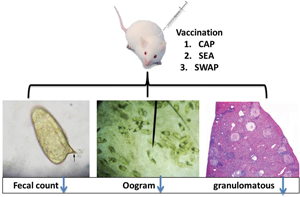Article contents
An Insight into the Potential Parasitological Effect of Schistosoma mansoni Antigens in Infected Mice: Prophylactic Role of Cercarial Antigen
Published online by Cambridge University Press: 22 June 2020
Abstract

Schistosomiasis is a multifactorial disease that includes environmental, behavioral, parasitic, vector, and host factors. This study aimed to assess the protective effect of single and polyvalent antigens from cercarial antigen preparations (CAPs), soluble worm antigen preparations (SWAPs), and soluble egg antigens (SEAs) which were used as candidate vaccines in an experimental model of Schistosoma mansoni-infected mice. The efficiency of the antigens was tested by determining their effects on fecal egg count, egg viability analysis, and tissue egg counts. Histological and morphometric analyses of granulomas in liver and intestine tissues were performed. In the present study, all immunized groups showed a significant reduction in the average fecal egg count and tissue egg load compared with infected mice. The most substantial reduction in fecal egg count was observed in the combined vaccinated group (23.23 ± 3.2). The group vaccinated with CAP before infection showed the highest reduction in tissue egg load (liver and intestine: 85.22 and 91.70%, respectively). Immunized animals showed a highly significant reduction in the numbers of hepatic granulomas compared with the infected non-immunized group. In conclusion, combining these different antigens (CAP, SWAP, and SEA) augments the protective immunity compared with other immunized groups.
Keywords
- Type
- Biological Applications
- Information
- Copyright
- Copyright © Microscopy Society of America 2020
References
- 3
- Cited by





